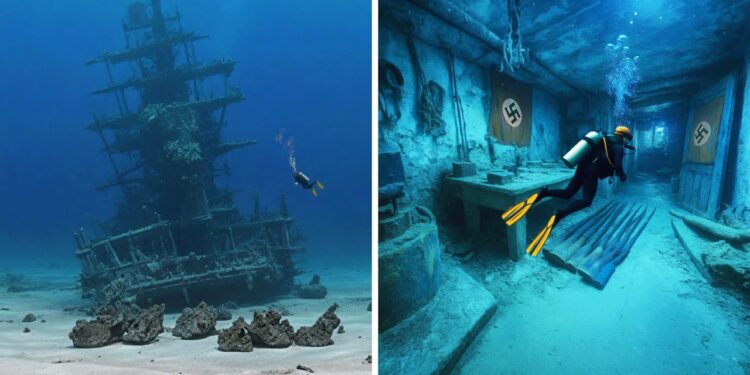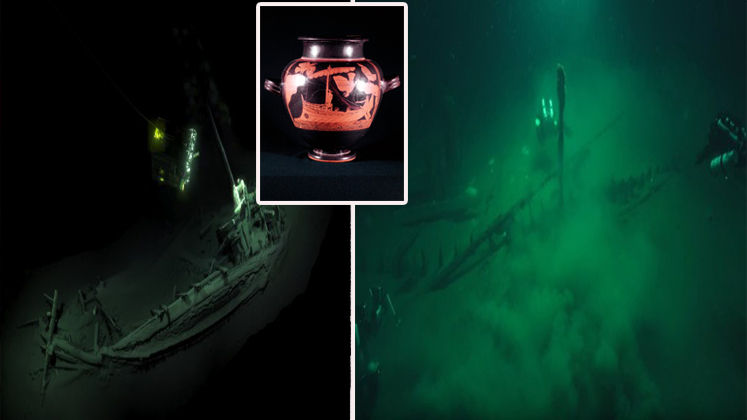Beneath the murky waters off Uruguay’s coast in the South Atlantic, 65 feet below the surface, lies the rusted wreck of the Admiral Graf Spee, a Nazi warship scuttled in 1939 to evade capture. Swallowed by silt and nearly forgotten, this World War II relic, a formidable “pocket battleship,” resurfaced in early 2025 when divers uncovered a sealed vault within its hull, revealing secrets that transformed its story from history to mystery.
Launched in 1934, the Graf Spee was a marvel of deception and engineering, officially listed at 10,000 tons to skirt Treaty of Versailles limits but closer to 16,000 tons. Armed with six 11-inch guns—unusually powerful for its size—and diesel engines enabling speeds of 29 knots, it could outrun stronger ships and outgun faster ones. In 1939, as war broke out, it was sent to the South Atlantic as a commerce raider to disrupt Allied merchant shipping. Under Captain Hans Langsdorff, it sank nine ships, totaling over 50,000 tons, without losing a single crew member from those vessels, adhering to humane wartime protocols.
Its reign ended in December 1939 during the Battle of the River Plate, the war’s first major naval clash. Three British cruisers—HMS Exeter, Ajax, and Achilles—engaged the Graf Spee off Uruguay. Despite damaging all three, the German ship sustained critical hits, forcing it into Montevideo Harbor for repairs. Neutral Uruguay granted only 72 hours, and British misinformation convinced Langsdorff a larger fleet awaited. Believing escape futile, he scuttled the ship on December 17, 1939, watched by thousands onshore as explosions tore through its hull. Days later, in Buenos Aires, Langsdorff took his life, wrapped in the German naval ensign.
For decades, the wreck’s superstructure protruded at low tide, a rusted ghost visited by tourists and locals. By the 1990s, silt and storms buried most of it, leaving only fragments visible. In 2004, a salvage operation recovered iconic artifacts: a 27-ton rangefinder, a feat of pre-digital precision, and a 7,200-pound bronze eagle with a swastika, sparking debates over its fate—display, destruction, or recasting as a dove. Smaller finds, like shell casings and personal effects, offered glimpses into life aboard. Yet, sealed compartments, including the command center and captain’s quarters, remained untouched, fueling rumors of hidden secrets.
In early 2025, an international team of marine archaeologists, led by Dr. Elena Koenig, revisited the wreck with advanced technology: autonomous submersibles equipped with 3D photogrammetry, sediment-penetrating radar, and high-frequency sonar. Scans revealed intact compartments, including a sealed chamber behind the conning tower, possibly a secondary communications room or archive. On March 11, 2025, a submersible named Kronos breached a rusted hatch, uncovering a locked metal case marked with a faded eagle emblem. Too fragile to open underwater, it was secured for later retrieval.
When the chamber was accessed, three weather-sealed trunks revealed astonishing contents: well-preserved documents, coded transmissions, personal notebooks, and customized Enigma machines with unique rotor settings for naval communications. The papers, stamped with Kriegsmarine seals, included logs of Allied shipping encounters, radio intercepts, and evasive tactics, such as shadowing neutral vessels to mask radar signatures. Personal logs, possibly from a senior officer or Langsdorff, blended technical notes with reflections on morale and doubts about Berlin’s strategy, offering a human perspective on the war’s early months.
These findings challenge assumptions, revealing tighter coordination with Berlin than previously thought and hinting at undocumented German naval operations. The documents and devices, currently under preservation and translation, are reshaping military history, with conferences and exhibits planned. The Graf Spee, once a sunken relic, is now a living archive, its vault opening new chapters in history. The full story remains unfolding, its depth still unknown.

























